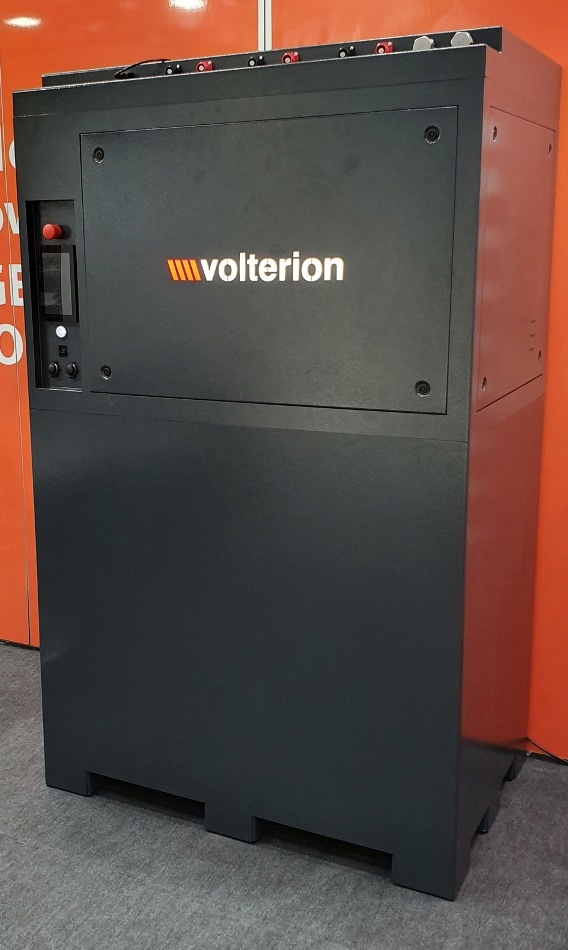Jun 4 2019
The amount of power that can be produced by renewable energy sources is not consistent; hence, batteries are used for the temporary storage of energy.
 Compact new redox flow batteries for storage of renewable energy. (Image credit: Fraunhofer UMSICHT)
Compact new redox flow batteries for storage of renewable energy. (Image credit: Fraunhofer UMSICHT)
While short service life is the drawback of lithium-ion batteries, redox flow batteries so far have been too expensive. However, ground-breaking new redox flow systems are currently available at the same price as lithium-ion batteries and have twice its service life. Volterion, an offshoot of the Fraunhofer Institute for Environmental, Safety and Energy Technology UMSICHT, has been successful in considerably decreasing the manufacturing costs involved.
The power supply relies on renewable energy sources to a large extent. However, their power generation output varies extensively, requiring a medium to store that electrical energy until it is needed. Powerful battery systems are also a fundamental component of other modern technology like electromobility solutions. For example, the power grid is neither equipped to house fast charging stations operating at 350 kW nor it covers all the sites where it would be sensible to set up such stations.
In such cases, lithium-ion batteries have restricted use, particularly because of their insufficiencies with regard to cycle durability. Charging and draining such batteries two or three times a day for two to three years would make them futile.
In contrast, redox flow batteries provide superior cycle durability and are also non-flammable, recyclable, and easily adaptable for both capacity and performance. Due to this, they are mainly suitable for applications in which batteries are subjected to high levels of stress. However, so far, despite these benefits, they have just been too expensive.
The First Affordable Redox Flow Batteries
Scientists at Fraunhofer UMSICHT in Oberhausen have been able to considerably reduce the costs involved in the production of redox flow batteries. The groundbreaking new batteries are produced and marketed by Fraunhofer spin-off Volterion. In order to gain insights into how the scientists have optimized the redox flow battery, it is necessary to briefly study how these batteries are developed.
Redox flow batteries comprise of stacks, which in turn include electrochemical cells to turn the electrical energy into chemical energy and electrolyte fluid tanks to store that chemical energy. This stack structure is the key reason why redox flow batteries are cost-prohibitive.
We’ve been able to reduce the cell weight to ten percent of the stack, which significantly reduces the cost. Whereas, in conventional stacks, the thickness of each cell was often as high as eight to ten millimeters, we’ve succeeded in cutting that down to two to three millimeters.
Dr Thorsten Seipp, Managing Director, Volterion
Seipp was also a former research scientist at Fraunhofer UMSICHT.
Due to the material saving, the new redox flow batteries have almost the same cost as a lithium-ion battery but have double the lifetime. This is for the first time that they are affordable for use in a broad variety of applications.
The Key is in the Material
Predominantly, the success is due to the enhancements made in the material. Stacks are usually composed of a graphite-polymer composite. However, such materials lose their polymer properties at the time of processing. The long polymer chains are unfastened, and the material loses its flexibility as well as part of its stability. Inter-cell connections cannot be soldered; instead, cells must be connected using threaded sealing rings.
“What we did at Fraunhofer UMSICHT was to modify the material and the manufacturing process in such a way that the material retains its polymer properties. As a result, the material remains stable and flexible and can be made significantly thinner, allowing the stacks to be welded together, and doing away completely with fast-wearing sealing rings,” explains Seipp.
Due to this, the manufacturing of the stacks is made much more cost-effective, and the stacks themselves are made more robust.
Applications from Sewage Treatment Plants to MRI Examinations
One of the application areas where the new redox flow batteries were first used is the sewage treatment plant. The plant presently uses methane to produce power, and there are strategies to utilize photovoltaic facilities too. A 100-kW battery would meet the fluctuations in energy generation as well as energy demand, and this will enable the sewage treatment plant to fulfill its whole energy needs self-sufficiently. Redox flow batteries could also be very helpful in hospitals as a power source for MRI scanners.
“Each MRI scanner has an output of 200 kilowatts, so if you have three or four running at the same time, the circuit is soon overloaded. Putting in a new power line is an expensive solution, costing 80,000 euros a kilometer, making a redox flow battery a good alternative,” states Seipp.
MRI scanners operate for a few minutes at a time, and at that time, they use up large amounts of power, before remaining inactive until the next examination. That implies that any battery powering the device is subjected to multiple charge cycles every day. “Our optimized batteries are as if made for this application—and indeed any application calling for short bursts of power in quantities that the grid cannot reliably provide,” concludes Seipp.
At present, the scientists at Fraunhofer UMSICHT are working together with colleagues from Volterion to make further cost savings in the manufacturing of the batteries. They are also expecting to increase the size of the applications. Currently, the batteries are intended to supply between 100 and 300 kW, but someday, this could be multiple megawatts.